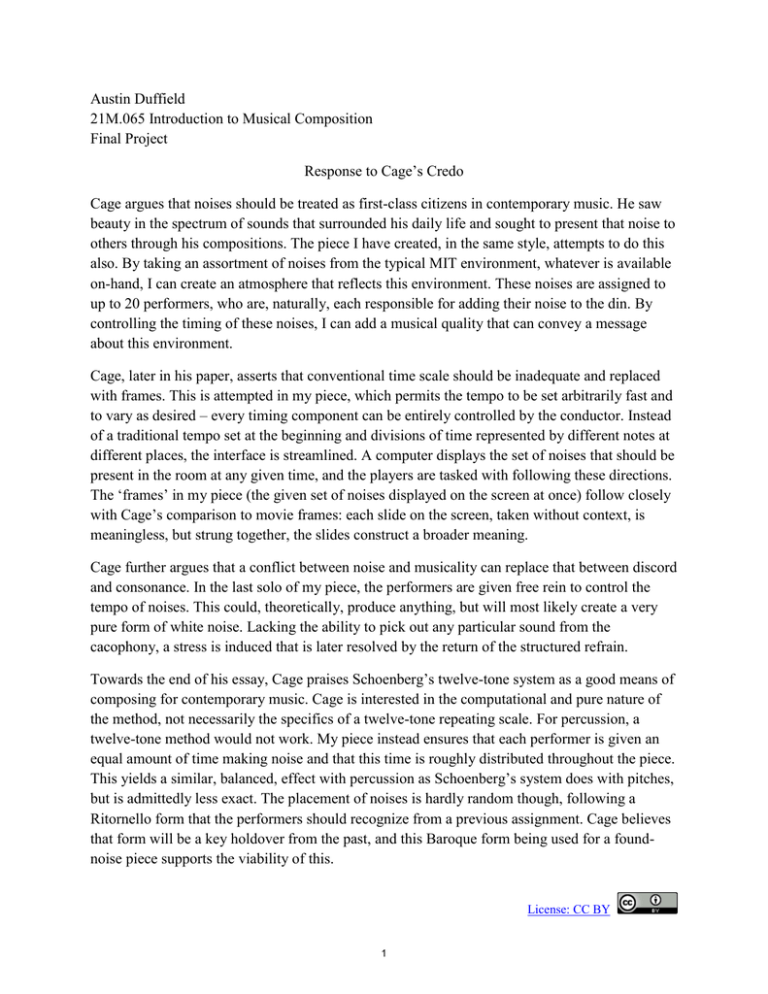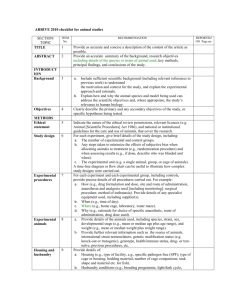Austin Duffield 21M.065 Introduction to Musical Composition Final Project Response to Cage’s Credo
advertisement

Austin Duffield 21M.065 Introduction to Musical Composition Final Project Response to Cage’s Credo Cage argues that noises should be treated as first-class citizens in contemporary music. He saw beauty in the spectrum of sounds that surrounded his daily life and sought to present that noise to others through his compositions. The piece I have created, in the same style, attempts to do this also. By taking an assortment of noises from the typical MIT environment, whatever is available on-hand, I can create an atmosphere that reflects this environment. These noises are assigned to up to 20 performers, who are, naturally, each responsible for adding their noise to the din. By controlling the timing of these noises, I can add a musical quality that can convey a message about this environment. Cage, later in his paper, asserts that conventional time scale should be inadequate and replaced with frames. This is attempted in my piece, which permits the tempo to be set arbitrarily fast and to vary as desired – every timing component can be entirely controlled by the conductor. Instead of a traditional tempo set at the beginning and divisions of time represented by different notes at different places, the interface is streamlined. A computer displays the set of noises that should be present in the room at any given time, and the players are tasked with following these directions. The ‘frames’ in my piece (the given set of noises displayed on the screen at once) follow closely with Cage’s comparison to movie frames: each slide on the screen, taken without context, is meaningless, but strung together, the slides construct a broader meaning. Cage further argues that a conflict between noise and musicality can replace that between discord and consonance. In the last solo of my piece, the performers are given free rein to control the tempo of noises. This could, theoretically, produce anything, but will most likely create a very pure form of white noise. Lacking the ability to pick out any particular sound from the cacophony, a stress is induced that is later resolved by the return of the structured refrain. Towards the end of his essay, Cage praises Schoenberg’s twelve-tone system as a good means of composing for contemporary music. Cage is interested in the computational and pure nature of the method, not necessarily the specifics of a twelve-tone repeating scale. For percussion, a twelve-tone method would not work. My piece instead ensures that each performer is given an equal amount of time making noise and that this time is roughly distributed throughout the piece. This yields a similar, balanced, effect with percussion as Schoenberg’s system does with pitches, but is admittedly less exact. The placement of noises is hardly random though, following a Ritornello form that the performers should recognize from a previous assignment. Cage believes that form will be a key holdover from the past, and this Baroque form being used for a foundnoise piece supports the viability of this. License: CC BY 1 The overarching theme of Cage’s paper is that contemporary music must seek to be what the technology of the day would naturally support, and this is what is attempted here. The use of a composer waving his hands before an orchestra is only necessary without precise timing and large monitors – a slide show works even better. The use of conventional instruments is good for preserving a particular noise for multiple audiences to experience over a long period of time, but can be replaced with a collection of noise-makers and loose structure. The loss of control over amplitude and particular arrangement of noises emphasizes the variety in the environment the piece seeks to present. License: CC BY 2 MIT OpenCourseWare http://ocw.mit.edu 21M.065 Introduction to Musical Composition Spring 2014 For information about citing these materials or our Terms of Use, visit: http://ocw.mit.edu/terms.




